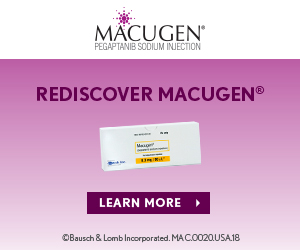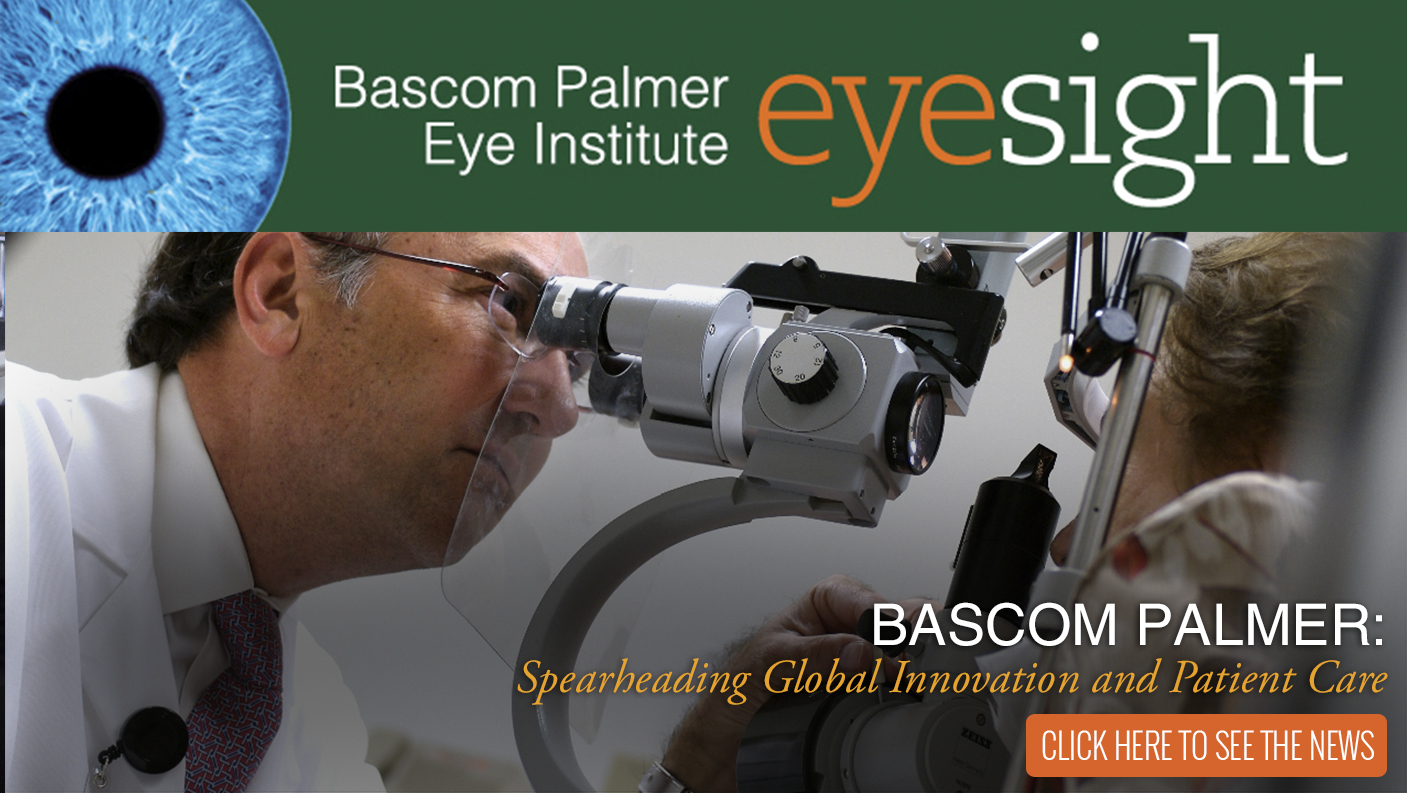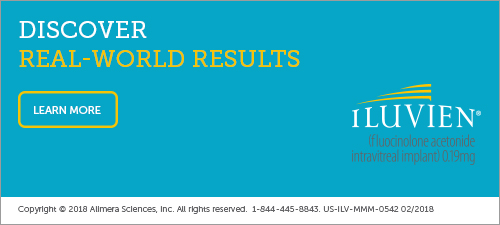
Volume 14, Number 3 |
March 2018 |

WELCOME to Review
of Ophthalmology's Retina Online newsletter. Each month, Medical Editor Philip Rosenfeld, MD, PhD, and our editors provide you with this timely and easily accessible report to keep you up to date on important information affecting the care of patients with vitreoretinal disease.
|

|
Plasma VEGF Concentrations After Intravitreous Anti-VEGF Therapy for DME
Researchers assessed systemic vascular endothelial growth factor-A levels after treatment with intravitreous aflibercept, bevacizumab or ranibizumab, as part of a comparative-effectiveness trial with participants randomly assigned to 2-mg aflibercept, 1.25-mg bevacizumab or 0.3-mg ranibizumab using a retreatment algorithm.
Participants included individuals with available plasma samples (n=436) collected before injections at baseline and four-, 52- and 104-week visits. Researchers compared systemic free-VEGF levels from an enzyme-linked immunosorbent assay across anti-VEGF agents in a preplanned secondary analysis, and were correlated with systemic side effects. Main outcome measures included changes in the natural log (ln) of plasma VEGF levels.
Baseline free-VEGF levels were similar across all three groups.
• At four weeks, mean ln (VEGF) changes were -0.30 ±0.61 pg/ml for the aflibercept group, -0.31 ±0.54 pg/ml for the bevacizumab group and -0.02 ±0.44 pg/ml for the ranibizumab group. The adjusted differences between treatment groups were -0.01 (CI, -0.12 to +0.10; p=0.89) for aflibercept-bevacizumab, -0.31 (-0.44 to -0.18; p<0.001) for aflibercept-ranibizumab and -0.30 (-0.43 to -0.18; p<0.001) for bevacizumab-ranibizumab.
• At 52 weeks, a difference in mean VEGF changes between bevacizumab and ranibizumab persisted (-0.23 [-0.38 to -0.09]; p<0.001); the difference between aflibercept and ranibizumab was -0.12 (p=0.07) and between aflibercept and bevacizumab was +0.11 (p=0.07).
• Treatment group differences at two years were similar to one year.
• No apparent treatment differences were detected at 52 or 104 weeks in the cohort of participants not receiving injections within one or two months before plasma collection.
• Participants with (n=9) and without (n=251) a heart attack or stroke had VEGF levels that appeared similar.
Researchers wrote that the data suggested that decreases in plasma free-VEGF levels were greater after treatment with aflibercept or bevacizumab compared with ranibizumab at four weeks. They found that a greater decrease was observed in bevacizumab vs. ranibizumab at 52 and 104 weeks. Results from two subgroups of participants who didn’t receive injections within at least one month and two months before collection suggested similar changes in VEGF levels after stopping injections. The findings didn’t illuminate whether VEGF levels returned to normal as the drug was cleared from the system or whether the presence of the drug affected the assay's ability to accurately measure free VEGF. Researchers noted no significant associations between VEGF concentration and systemic factors.
SOURCE: Jampol LM, Glassman AR, Liu D, et al. Plasma vascular endothelial growth factor concentrations after intravitreous anti-vascular endothelial growth factor therapy for diabetic macular edema. Ophthalmology 2018; March 7. [Epub ahead of print].
Aqueous Humor Cytokine Levels & Intravitreal Ranibizumab in DME
Investigators wrote that variability in response to anti-vascular endothelial growth factor treatment in diabetic macular edema remains a significant clinical challenge and that biomarkers could help anticipate responses to anti-VEGF therapy. As such, investigators analyzed aqueous humor cytokine level changes in response to intravitreal ranibizumab therapy for the management of DME, and determined the association between baseline aqueous levels and anatomic response.
As part of a prospective, multicenter cohort study, they recruited from December 22, 2011, to June 13, 2013, 49 participants with diabetes mellitus complicated by center-involving DME, with a central subfield thickness of 310 μm or greater (as revealed on spectral-domain optical coherence tomography), and performed statistical analyses from March 1, 2017, to June 1, 2017. A total of 48 participants proceeded to follow-up.
Participants received monthly injections of ranibizumab (0.5 mg) for three months. Aqueous fluid for cytokine analysis was obtained at baseline and at the two-month visit, and investigators carried out multiplex immunoassays in duplicate for:
• VEGF;
• placental growth factor;
• transforming growth factor beta 2;
• intercellular adhesion molecule 1;
• interleukin 6;
• IL-8;
• IL-10;
• vascular intercellular adhesion molecule; and
• monocyte chemoattractant protein 1.
Main outcomes and measures included baseline and two-month changes in aqueous cytokine levels, three-month changes in SD-OCT central subfield thickness and macular volume, and the statistical association between baseline aqueous cytokine levels and measures of anatomic response to ranibizumab in center-involving DME.
Among the 48 participants, the mean (SD) age was 61.9 (7.1) years; 36 participants (75 percent) were men. The following cytokines were lower at month two vs. baseline:
• ICAM-1 (median change, -190.88; interquartile range, -634.20 to -26.54; p<0.001);
• VEGF (median change, -639.45; IQR, -1,040.61 to -502.61; p<0.001);
• placental growth factor (median change, -1.31; IQR, -5.99 to -0.01; p<0.001);
• IL-6 (median change, -38.61; IQR, -166.72 to -2.80; p<0.001); and
• monocyte chemoattractant protein 1 (median change, -90.13; IQR, -382.74 to 109.47; p=0.01).
When controlling for age, foveal avascular zone size and severity of retinopathy, multiple linear regression determined that increasing baseline aqueous ICAM-1 was associated with a favorable anatomic response in terms of reduced SD-OCT MV at three months (every additional 100 pg/mL of baseline ICAM-1 was associated with a reduction of 0.0379 mm3; p=0.01). Conversely, increasing baseline aqueous VEGF was associated with a less favorable SD-OCT MV response at three months (every additional 100 pg/mL of baseline VEGF was associated with an increase of 0.0731 mm3; p=0.02) and was associated with lower odds of being a central subfield thickness responder (OR, 0.868; CI, 0.755-0.998).
Investigators determined that elevated aqueous ICAM-1 and reduced VEGF levels at baseline were associated with a favorable anatomic response to ranibizumab in DME, although the findings didn’t always reveal a direct correlation between anatomic and visual acuity response.
SOURCE Hillier RJ, Ojaimi E, Wong DT, et al. Aqueous humor cytokine levels and anatomic response to intravitreal ranibizumab in diabetic macular edema. JAMA Ophthalmol 2018; Mar 8.[Epub ahead of print].
Early Anatomic Response to Anti-VEGF Therapy & Long-term Outcome in DME
Scientists analyzed the relationship between early retinal anatomical responses, and long-term anatomical and visual outcomes with ranibizumab in center-involved diabetic macular edema in a post hoc analysis.
Eyes randomized to the ranibizumab with prompt laser and ranibizumab plus deferred laser treatment arms in the Protocol I study were categorized by proportional reduction (<20 vs. ≥20 percent) in central retinal thickness after 12 weeks. Adjusted and unadjusted analyses assessed the association between early (week 12) anatomical response and long-term (weeks 52 and 156) anatomical and best-corrected visual acuity outcomes.
Of 335 study eyes, 118 showed limited (<20 percent) and 217 showed strong (≥20 percent) CRT reduction at week 12. In unadjusted and adjusted analyses, limited early CRT response was negatively, and significantly, associated with strong CRT response at weeks 52 and 156. Sensitivity analyses indicated that this association was robust and unrelated to any “floor effect.” In unadjusted analyses, a strong, early CRT response was associated with greater long-term improvement in best-corrected visual acuity; after controlling for confounders, however, the association lost statistical significance.
Scientists wrote that, in their view, early CRT response to ranibizumab was a significant prognostic indicator of medium- to long-term anatomical outcomes in center-involved diabetic macular edema.
Source: Dugel PU, Campbell JH, Kiss S, et al. Association between early anatomic response to anti-vascular endothelial growth factor therapy and long-term outcome in diabetic macular edema: An independent analysis of protocol I study data. Retina 2018; Feb 22. [Epub ahead of print].
Characteristics of Foveal Cystoid Spaces & Response to Ranibizumab With DME
Scientists looked at the association between the characteristics of foveal cystoid spaces and short-term responsiveness to ranibizumab treatment for diabetic macular edema at three months from the initial injection.
They retrospectively reviewed 66 eyes of 61 individuals with center-involved DME who received three consecutive ranibizumab injections and follow-up, as-needed administrations. They evaluated the relationship between visual improvement at three months and preoperative optical coherence tomography parameters including hyperreflective foci, heterogeneous OCT reflectivity, mean levels of OCT reflectivity and height of foveal cystoid spaces.
Twenty-three eyes without preoperative hyperreflective foci in the foveal cystoid spaces had significantly greater improvement in logMAR visual acuity at three months than 43 eyes with foci (p=0.006). That was similar to the greater reduction in CSF thickness in eyes without lesions after treatment at the same time point (p<0.001). VA improvement at three months wasn’t associated with the height (R=0.215, p=0.083) or reflectivity levels (R=-0.079, p=0.538) of foveal cystoid spaces. There were no differences in VA changes between eyes with and without heterogeneous reflectivity in foveal cystoid spaces (p=0.297). Multivariate analyses showed that the logMAR VA and absence of hyperreflective foci in foveal cystoid spaces were associated with VA improvement at three months.
Scientists determined that hyperreflective foci in foveal cystoid spaces at baseline predicted poorer short-term responsiveness to ranibizumab injections for DME.
SOURCE: Murakami T, Suzuma K, Uji A, et al. Association between characteristics of foveal cystoid spaces and short-term responsiveness to ranibizumab for diabetic macular edema. Jpn J Ophthalmol 2018; Feb. 19. [Epub ahead of print].
Bimanual Microincision Vitreous Surgery for Severe Proliferative DR
Investigators evaluated the visual and anatomical outcomes, and safety of bimanual microincision vitreous surgery for severe proliferative diabetic retinopathy. The retrospective review included 315 eyes of 282 individuals who underwent 23-gauge or 25-gauge pars plana vitrectomy with bimanual membrane dissection for diabetic tractional detachment from January 2007 to September 2016.
Minimum follow-up was three months, and the average duration of follow-up was 23 months (range: three to 100 months; median: 15 months). Outcome measures were best-corrected visual acuity, anatomical success and postoperative complications.
Findings included the following:
• 84.3 percent of eyes improved (>2 lines), 10.5 percent were stable and 5.4 percent worsened (>2 lines) postoperatively;
• two-line improvement was seen in 87.4 percent of 23-gauge eyes compared with 79.7 percent of 25-gauge eyes (p=0.029);
• mean peak BCVA improved from 20/930 (1.67 ±0.63) preoperatively to 20/120 (0.78 ±0.63) postoperatively (p<0.001);
• primary reattachment was achieved in 310 eyes (98.4 percent) and final reattachment in 312 eyes (99 percent);
• recurrent vitreous hemorrhage was the most common postoperative complication (18.4 percent);
• lower incidence of recurrent vitreous hemorrhage was seen with 25 gauge (13.5 percent) compared with 23 gauge (22 percent, p=0.038); and
• epiretinal membrane formation (7.9 percent), intractable glaucoma (2.5 percent) and endophthalmitis (0.6 percent) were other postoperative complications.
Investigators found sustained visual improvement, anatomical restoration and low complication rates in bimanual microincision vitreous surgery in a large series. Visual outcomes were poorer in older individuals, tractional retinal detachments involving the macula, and eyes with extensive membranes and silicone oil as tamponade. Investigators added that 23- and 25-gauge groups were comparable in visual improvement, anatomical success, and intraoperative and postoperative complications.
SOURCE: Shroff CM, Gupta Charu, Shroff D, et al. Bimanual microincision vitreous surgery for severe proliferative diabetic retinopathy: Outcome in more than 300 eyes. Retina 2018; Feb. 5. [Epub ahead of print].

Conbercept for Treatment-naive nAMD
Scientists evaluated the safety and efficacy of intravitreal conbercept in individuals with treatment-naive neovascular age-related macular degeneration in a real-life setting in China.
The study involved three consecutive intravitreal injections of conbercept following a pro re nata protocol. The main outcomes were changes in Early Treatment Diabetic Retinopathy Study best-corrected visual acuity and central retinal thickness between the baseline and month 12.
Mean BCVA improved from 39.39 ±24.91 letters at baseline to 44.26 ±22.89 letters at the final follow-up (p<0.001). At month 12, the proportion of optimal responses was 43.48 percent compared with 36.96 percent of poor responses and 19.56 percent of nonresponses. A mean central retinal thickness of 480.94 ±178.47 μm at baseline was significantly reduced to 366.33 ±173.52 μm at month 12. Subjects received a median of 5.32 intravitreal injections. At month 12, scientists found that the mean change in BCVA of eyes with intraretinal cystoid fluid at baseline was markedly lower than that of eyes without intraretinal cystoid fluid. No adverse events were attributed to conbercept.
Scientists wrote that, at the 12-month follow-up, conbercept was shown to be a safe and effective treatment for individuals with treatment-naive nAMD in a real-life setting.
SOURCE: Li X, Luo H, Zuo C, et al. Conbercept in patients with treatment-naive neovascular age-related macular degeneration in real-life setting in China. Retina. 2018 Mar 15.

Quantitative Evaluation of CNV under PRN Anti–VEGF Therapy with OCTA
Researchers used optical coherence tomography angiography-derived quantitative metrics to assess the response of choroidal neovascularization to pro re nata anti-vascular endothelial growth factor treatment in neovascular age-related macular degeneration, as part of a prospective, longitudinal cohort study.
Fourteen eyes from 14 study participants with treatment-naïve neovascular AMD were enrolled, evaluated monthly and treated with intravitreal anti-VEGF agents under a PRN protocol for one year. At each visit, two 3 × 3 mm2 OCTA scans were obtained. Researchers applied custom image processing to segment the outer retinal slab, suppress projection artifact and automatically detect CNV. They also calculated CNV membrane area and vessel area.
Main outcome measures included individual and mean CNV membrane area and vessel area at each visit, with within-visit repeatability determined by coefficient of variation.
Eight eyes showed the CNV to be within the 3 × 3 mm2 scanning area and had adequate image quality for quantification. One individual was excluded from analysis due to presence of a large subretinal hemorrhage overlying the CNV membrane. In the remaining individuals, CNV vessel area was reduced by 39 percent at one month, 50 percent at three months, 43 percent at six months and 41 percent at 12 months. The CNV membrane area was reduced by 39 percent at one month, 51 percent at three months, 54 percent at six months and 45 percent at 12 months. At month six, the mean change from baseline wasn’t statistically significant for the CNV vessel area, whereas it was statistically significant for the CNV membrane area. Neither metric was significantly different compared with the baseline at month 12. Individual analyses revealed each CNV had a unique response under the PRN treatment. Within-visit repeatability was 7.96 percent (coefficient of variation) for CNV vessel area and 7.37 percent for CNV membrane area.
In this exploratory study of CNV response to PRN anti-VEGF treatment, CNV vessel area and membrane area were reduced compared with baseline after three months; after one year of follow-up, these reductions were no longer statistically significant. When the anti-VEGF treatment was withheld, increasing CNV vessel area over time often resulted in exudation, but it wasn’t possible to determine exactly when exudation occurs.
SOURCE McClintic SM, Gao S, Wang J, et al. Quantitative evaluation of choroidal neovascularization under pro re nata anti-vascular endothelial growth factor therapy with OCT angiography. Ophthalmology Retina 2018; March 2. [Epub ahead of print].

ARMS2 A69S & CFH Y402H Risk in Wet AMD
Investigators designed a meta-analysis to pool studies that analyzed CFH (Y402H or I62V) and ARMS2 A69S in the same samples to compare the effect of CFH and ARMS2 in neovascular AMD.
Included studies had genotype data of studied groups for ARMS2 A69S and CFH. To modify the heterogeneity in the variables, investigators used a random-effects model. They performed meta-analyses using STATA, in addition to funnel plots and Egger’s regression tests for evaluation of possible publication bias.
Overall, researchers included 6,676 neovascular AMD cases and 7,668 controls. Pooled overall odds ratios (95%, CI) for neovascular AMD/control were:
• ARMS2 A69S: OR=2.35 (2.01 to 2.75) for GT vs. GG; OR=8.57 (6.91 to 10.64) for TT vs. GG;
• CFH Y402H: OR=1.94 (1.73 to 2.18) for CT vs. TT; OR=4.89 (3.96 to 6.05) for CC vs. TT;
• ARMS2 A69S genotype OR/CFH Y402H genotype OR (homogeneous genotypes):
Asia=2.14; Europe: 1.87; America: 1.82; Middle East: 3.56; pooled: 1.75; and
• ARMS2 A69S genotype OR/CFH Y402H genotype OR (heterogeneous genotypes): Asia=0.93; Europe: 1.39; America: 2.06; Middle East: 1.20; pooled: 1.21.
The studies revealed that ARMS2 A69S risk genotypes had stronger predisposing effects on neovascular AMD compared with CFH Y402H risk genotypes.
Investigators wrote that the inclusion criteria to select studies that analyzed the effect of these two loci in the same case-control samples showed a much stronger effect with ARMS2 A69S for neovascular AMD compared with CFH Y402H.
SOURCE: Bonyadi MHJ, Yaseri M, et al. Comparison of ARMS2/LOC387715 A69S and CFH Y402H risk effect in wet-type age-related macular degeneration: A meta-analysis. Int Ophthalmol 2018; Feb 8. [Epub ahead of print].

Development and Course of Scars in AMD Treatments Trials
Researchers described risk factors for scar formation and changes to fibrotic scars through five years in the Comparison of Age-related Macular Degeneration Treatments Trials, as part of a multicenter, prospective cohort study.
A total of 1,061 subjects participated in CATT. Researchers evaluated color photographic and fluorescein angiographic images from baseline and one, two and five years. They estimated the incidence of scar formation with Kaplan-Meier curves and assessed risk factors with Cox regression models. Main outcome measures included scar formation, fibrotic scar area and macular atrophy associated with fibrotic scars.
The cumulative proportion of eyes with scars was 32 percent at one year, 46 percent at two years and 56 percent at five years. Baseline factors associated with increased risk (adjusted hazards ratio and 95% CI) were:
• classic choroidal neovascularization (aHR, 4.49; CI, 3.34 to 6.04) vs. occult;
• hemorrhage >1 disc area (aHR, 2.28; CI, 1.49 to 3.47) vs. no hemorrhage;
• retinal thickness >212 μm (aHR, 2.58; CI, 1.69 to 3.94) vs. <120 μm;
• subretinal tissue complex thickness >275 μm (aHR, 2.64; CI, 1.81 to 3.84) vs. ≤75 μm;
• subretinal fluid thickness >25 μm (aHR, 1.31; CI, 0.97 to 1.75) vs. no fluid;
• visual acuity in fellow eye 20/20 (aHR, 1.72; CI, 1.25 to 2.36) vs. 20/50 or worse;
• retinal pigment epithelium elevation absence (aHR, 1.71; CI, 1.21 to 2.41); and
• subretinal hyperreflective material (aHR, 1.72; CI, 1.25 to 2.36).
Among 68 eyes that developed fibrotic scars at one year, VA decreased by a mean of an additional 13 letters between years one and five. Mean scar area was 1.2 disc area at one year, 1.2 disc area at two years and 1.9 disc area at five years. Atrophy was present in 18 percent at one year, 24 percent at two years and 54 percent at five years. Mean areas were 1.6, 2 and 3.1 disc areas. Atrophy replaced fibrotic scars in eight eyes at five years. Researchers found no significant correlation between scar and atrophy growth; the rate of growth for both was similar between the clinical trial and observation periods.
Researchers found that several morphologic features, including classic CNV and large hemorrhages, were associated with scar formation. In addition, they wrote, rates of new scar formation declined after two years, and most fibrotic scars and accompanying macular atrophy expanded over time, reducing VA.
SOURCE: Daniel E, Pan W, Ying GS, et al. Development and course of scars in the comparison of age-related macular degeneration treatments trials. Ophthalmology 2018; Feb 14. [Epub ahead of print].

Predicting VA Using Machine Learning in Individuals Treated for nAMD
Researchers aimed to predict, using machine learning, visual acuity at three and 12 months in individuals with neovascular age-related macular degeneration after an initial upload of three anti-vascular endothelial growth factor injections, as part of a database study.
They included 653 individuals (379 female) with 738 eyes and an average age of 74.1 years. The baseline VA before the first injection was 0.54 logMAR (±0.39). A total of 456 of individuals (270 female, 508 eyes, average age: 74.2 years) had sufficient follow-up data to be included for a 12-month VA prediction. The baseline VA before the first injection was 0.56 logMAR (±0.42).
Researchers used five different machine-learning algorithms (AdaBoost.R2, Gradient Boosting, Random Forests, Extremely Randomized Trees, and Lasso) to predict VA in neovascular AMD cases after treatment with three anti-VEGF injections. Clinical data features came from a data warehouse containing electronic medical records and OCT measurement features. Researchers predicted the VA of eyes excluded from machine learning and compared the findings with the actual VA (“ground truth”) as recorded in the data warehouse. Main outcome measures included the difference in logMAR VA after a three- and 12-month upload phase between prediction and ground truth.
For the three-month VA forecast, the difference between the prediction and ground truth was between 0.11 logMAR (5.5 letters) mean absolute error/0.14 logMAR (seven letters) root mean square error and 0.18 logMAR (nine letters) MAE/0.2 logMAR (10 letters) RMSE. For the 12-month VA forecast, the difference between the prediction and ground truth was between 0.16 logMAR (eight letters) MAE/0.2 logMAR (10 letters) RMSE and 0.22 logMAR (11 letters) MAE/0.26 logMAR (13 letters) RMSE. The Lasso protocol was the best performing algorithm.
Researchers found that machine learning enabled VA to be predicted for three months with comparable results to VA measurement reliability.
SOURCE: Rohm M, Tresp V, Müller M, et al. Predicting visual acuity by using machine learning in patients treated for neovascular age-related macular degeneration. Ophthalmology 2018; Feb 14. [Epub ahead of print].

|




